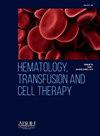EFFECTS OF A CONVENTIONAL CHELATOR-MODIFIED ANTI-INTEGRIN PEPTIDE ON GLIOBLASTOMA CELL PROLIFERATION AND MIGRATION
IF 1.8
Q3 HEMATOLOGY
引用次数: 0
Abstract
Introduction/Justification
Glioblastoma (GB) is the most aggressive brain tumor, with high morbidity and mortality rates. The overall survival of GB patients is only 14 months, not improved by the traditional or latest therapeutic options, as surgical resection, temozolomide chemoradiation or gefitinib. FAPESP-founded “Cancer Innovation Center with Emphasis on Metals and Theranostics” (CancerThera) is dedicated to the development of new metallopharmaceuticals and radiopharmaceuticals for tumor diagnosis and treatment. Among these developments, an anti-integrin peptide modified by a conventional spacer (C6) and chelator (DOTA) was evaluated as a potential treatment of GB. Overexpressed in GB, integrins are transmembrane proteins that play essential roles in cell proliferation and migration. Therefore, integrin inhibition may be a potential targeted therapy for GB patients.
Objectives
The study aimed to evaluate the effects of the DOTA-C6-anti-integrin peptide on GB cell lines proliferation and migration, as an initial step for GB theranostic development.
Materials and Methods
The anti-proliferative activity of the DOTA-C6-anti-integrin peptide (0.01 nM - 100 µM) was evaluated in human GB (U87, U118, and U251), murine GB (GL261), and non-tumoral cell lines (HaCaT), by considering the cell amounts at baseline and 48h after exposure (two untreated control groups). Cells were fixed with 50% trichloroacetic acid and stained with sulforhodamine B. Spectrophotometric absorbance was performed at 540nm in a microplate reader. Cell migration was assessed in U118, U251, and Gl261 cells treated with the DOTA-C6-anti-integrin peptide (1 µM - 100 µM) using the wound-healing assay. Wound cells were photographed immediately (0h) and after 24h. Images were analyzed by the ImageJ software (National Institutes of Health). For statistical analysis, samples did assume normal distribution in Shapiro-Wilk's test, thus we used t test to compare the groups using SPSS 21 software (SPSS Incorporation). Resultados: At the tested concentration range, the DOTA-C6-anti-integrin peptide did not affect proliferation of GB and HaCaT cell lines. In U118 cells, we observed that treatment with the DOTA-C6-anti-integrin peptide had no effect on cell migration at any of the tested concentrations. In contrast, in U251 cells, the treatment significantly inhibited migration compared to untreated cells at a concentration of 100 µM (p = 0.03). In Gl261 cells, the treatment significantly inhibited migration compared to untreated cells at concentrations of 1 µM and 0.1 µM (p = 0.04).
Conclusion
Despite the lack of anti-proliferative effect, the DOTA-C6-anti-integrin peptide inhibited migration in GB cell lines, U251 and Gl261. An invasive pattern being a GB hallmark, our data suggests that the DOTA-C6-anti-integrin peptide may aid in developing a GB theranostic agent.
Acknowledgements
The study was supported by Coordenação de Aperfeiçoamento de Pessoal de Nível Superior (CAPES), Conselho Nacional de Desenvolvimento Científico e Tecnológico (CNPq #429463/2018-9), Fundação de Apoio ao Ensino e à Pesquisa do Estado de São Paulo (FAPESP #2023/09738-4, FAPESP #2023/012810-9, Cancer Theranostics Innovation Center (CancerThera), CEPID FAPESP #2021/10265-8), and International Atomic Energy Agency (IAEA) technical cooperation projects for development of Latin American Countries (IAEA/TCLAC: EX-BRA6033-2401375).
传统螯合剂修饰的抗整合素肽对胶质母细胞瘤细胞增殖和迁移的影响
本文章由计算机程序翻译,如有差异,请以英文原文为准。
求助全文
约1分钟内获得全文
求助全文
来源期刊

Hematology, Transfusion and Cell Therapy
Multiple-
CiteScore
2.40
自引率
4.80%
发文量
1419
审稿时长
30 weeks
 求助内容:
求助内容: 应助结果提醒方式:
应助结果提醒方式:


